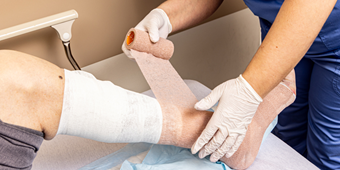Ovarian Dermoid Cysts Much Different Than Other Cell Growths

Find Your Perfect Match
Answer a few questions and we'll provide you with a list of primary care providers that best fit your needs.
Women in their childbearing years are at greater risk for developing ovarian dermoid cysts – a unique type of growth much different than any other cyst.
“What’s interesting about a dermoid that makes it different than any other cyst on the ovary is that it comes from germ cell material that grows all three layers of tissue found in the body,” said obstetrician and gynecologist Larry Holland, DO. “Therefore, these cysts can contain material such as hair, skin, sweat glands, fat, bone, nails, teeth, cartilage, and in rare occasion, thyroid tissue.”
Most women who develop a dermoid cyst on their ovaries are around 30 years of age. The majority – or 98 percent – of ovarian dermoid cysts are benign. However, the discovery and treatment of ovarian dermoid cysts is still important since it can pose other risks to a woman’s health, such as infection or torsion.
“If a dermoid cyst gets big enough, it can rotate on its axis and become a surgical emergency,” said Dr. Holland. “This twisting, also known as torsion, can happen and not be detected up to 16 percent of the time. If it stays that way too long it may mean the loss of an ovary. For this reason, ovarian torsion is one of the most common emergencies when it comes to gynecological surgeries.”
Women Often ‘Asymptomatic’
Catching an ovarian dermoid cyst early is also important because it’s the only cyst that can develop bilaterally – meaning if it is present on one ovary it may be likely that another one is present on the other one, Dr. Holland said. So, how can a woman know if she has a dermoid cyst on her ovary? Women are asymptomatic the majority of the time, but symptoms do exist especially when the cyst has become large in size.
A large dermoid cyst can cause abdominal pain, abnormal bleeding and painful intercourse. A cyst that is pushing on a woman’s bladder can also cause difficulty with urination. Nausea, vomiting, weight changes and pressure in the pelvis area are also signs, Dr. Holland said.
Women diagnosed with an ovarian dermoid cyst should keep the following points in mind:
- It’s a very common condition. Dermoid cysts make up about 20 percent of all abnormal growths found on the ovaries. It’s considered the most common abnormal growth found in women younger than 20 years of age.
- It might surface during pregnancy. Dermoid cysts can be detected when a woman is pregnant. Physicians will make every attempt to leave it alone until after the baby is born, but may remove it in rare cases when it appears to be at risk for torsion.
- It can be successfully treated. A dermoid cyst that is still intact can be removed, and in most cases, be done laparoscopically. This non-invasive approach usually allows women to return home just hours after the procedure.
- It doesn’t always mean a loss of an ovary. The initial goal is to remove the cyst with the hopes of leaving a portion of the ovary still in place. Dr. Holland said this can be done in more than half of cases.
“Our goal is to save the ovary,” he said. “A women only needs 10 percent of one ovary to give her the hormones her body needs for her entire life. And for women in their reproductive years, we want to save as much of the ovary as possible.”
Find Your Perfect Match
Answer a few questions and we'll provide you with a list of primary care providers that best fit your needs.
Source: Larry Holland, DO, Premier Women's Center




